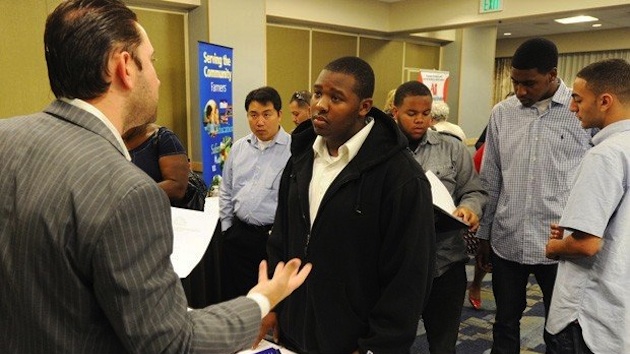

An unemployed American speaks to a recruiter at a jobs fair. (Photo: Mark Ralston AFP/Getty)
A nation’s prosperity is determined by the quantity and quality of labor and capital that are productively utilized. Which means that it doesn’t make sense to have policies that penalize either saving and investment or working.
Yet that seems to be the favorite hobby of the political class.
And there are real consequences. A new study by a pair of economists, published by the National Bureau of Economic Research, has some interesting findings on the link between redistribution programs and labor supply.
It’s a bit wonky, given the way academics write, but they produce some important data on the negative unintended consequences of government dependency.
…we find that the decline in desire to work since the mid-90s lowered the unemployment rate by about 0.5 ppt and the participation rate by 1.75 ppt. This is a large effect… Our estimates imply that changes in the provision of welfare and social insurance (notably disability insurance) explain about 50 percent of the decline in desire to work, which suggest a possible role for the major welfare reforms of the 90s – the 1993 Earned Income Tax Credit (EITC) expansion and the 1996 reform of the Aid to Families with Dependent Children (AFDC) program…the possibility that changes in the provision of social transfers can affect desire to work and thereby the aggregate unemployment and participation rates echoes Juhn, Murphy and Topel (2002) and Autor and Dugan (2003) who argue that the growing attractiveness of disability benefits relative to work increased the number of individuals outside the labor force. …Most strikingly, receiving…disability insurance substantially reduces the probability to want to work by 17 percentage points (ppt), consistent with the fact that an impairment should preclude any work activity and thus lower desire to work.
The authors openly warn that it’s difficult to separate out the effects of various redistribution programs.
The mid-1990s welfare reform apparently helped labor supply by pushing recipients to get a job.
Disability programs, by contrast, strongly discourage productive behavior, while wage subsidies such as the earned-income credit ostensibly encourage work but also can discourage workforce participation for secondary earners in a household.
Here are more of their findings.
…the Earned-Income Tax Credit (EITC) program, a program aimed at o§setting the social security payroll tax for low-income families with children, was expanded in order to encourage work effort (Rothstein and Nichols, 2014). …After controlling for characteristics, we find that the EITC explains 71 percent of the decline in low-educated married mothers’ desire to work between 1988-1993 and 1994-2010. …While the “welfare to work” reform was designed to do bring welfare recipients into the labor force, the reform could have had the opposite effect on the “weaker” nonparticipants by shifting them from a program with some connection to the labor force (welfare) to a program with no connection to the labor force (disability insurance). …Our cross-sectional estimates imply that changes in the provision of welfare and social insurance explain about 60 percent of the decline in desire to work among prime-age females, while the difference-in-difference estimates attribute between 50 and 70 percent of the decline in mothers’ desire to work to the welfare reforms. We conjecture that two mechanisms could explain these results. First, the EITC expansion raised family income and reduced secondary earners’ (typically women) incentives to work.
For non-academic readers, these two charts from the NBER study will be easier to understand.
The first chart shows what should be good news. Welfare reforms in the 1990s led to a big drop in dependency.
But now it’s time for the bad news.
Welfare reform reduced one type of dependency, but other redistribution programs have ballooned.
So no wonder there’s now research showing unfortunate results.
Writing for Investor’s Business Daily, John Merline addresses the same issue, but looking at different redistribution programs.
…the share of 25- to 54-year-olds who are active in the labor market has steadily fallen, to the point where just over 80% of this age group is either working or looking for work. …University of Chicago economics professor Casey Mulligan…posits that the root cause was an attempt by Congress to help people displaced by the recession. Democrats who controlled Congress at the time made several changes to anti-poverty subsidies, adding things like mortgage assistance programs, the benefits of which are phased out as income rises. ObamaCare provides still another one, by offering insurance subsidies that also phase out. …these programs…add to what is already a steep effective marginal tax rate for those in the phase-out range.
In other words, the redistribution programs alter incentives to work since people implicitly calculate the costs and benefits of productive behavior.
Mulligan figures the top rate for these families eligible for various federal aid programs went from 40% to 48% in the immediate aftermath of the recession. In other words, for every extra dollar someone eligible for various aid programs makes, they lose 48% from taxes and benefit reductions. …Mulligan says. “The more you help low-income people, the more low-income people you’ll have. The more you help unemployed people, the more unemployed people you’ll have.”
John is right to cite Prof. Mulligan’s work.
I cited his work last year showing how Obamacare undermined incentives to work. And other academics have reached the same conclusion.
Regarding the broader issue of redistribution and dependency, I argue that federalism is the best approach, both because states will face competitive pressure to avoid excessively generous benefits and because states will learn from each other about the best ways to help the truly needy while minimizing the negative impact of handouts on incentives for productive behavior.
Or we could just keep the current system, which is bad for both poor people and taxpayers.
P.S. This Wizard-of-Id parody contains a lot of insight about labor supply and incentives. As does this Chuck Asay cartoon and this Robert Gorrell cartoon.
P.P.S. If you want some jokes referencing the disability program, we have the politically correct version of The Little Red Hen, as well as two very similar jokes about Jesus performing miracles and how liberals differ from conservatives and libertarians.
P.P.P.S. Switching to a different topic, the IRS is whining that it needs to a bigger budget to better “service” taxpayers.
The Washington Examiner has a great editorial on the topic. Here are some of the better passages.
Oh, those poor dears at the IRS. They wasted $50 million on 225 conferences between 2010 and 2012, including a single $4.1 million conference in Anaheim, Calif. They wasted $50,000 creating bad videos on the clock, including one of the worst Star Trek parodies in the history of the Internet. They gave raises and bonuses to employees who hadn’t paid their own taxes. They were caught targeting applicants for nonprofit status based on their ideology and potential opposition to President Obama. They lied to Congress about being unable to recover emails from those involved.
Yet the bureaucracy still wants more money.
IRS Commissioner John Koskinen warned that taxpayers would suffer… But according to a new report by the House Ways and Means Committee, these inconveniences were the result of IRS malingering – of budgetary choices made within the agency itself….“Spending decisions entirely under the IRS’s control led to 16 million fewer taxpayers receiving IRS assistance this filing season,” said the report. “Other spending choices, including prioritizing employee bonuses and union activity on the taxpayer’s dime, used up resources that otherwise could have been used to assist another 10 million taxpayers.” This is a classic example of how federal bureaucrats take revenge when their budgets are cut. Instead of prioritizing limited resources in order to fulfill their agencies’ missions, they find ways to transfer the maximum amount of pain directly to taxpayers, so as to teach the country a lesson about how indispensable they are.
In other words, a classic example of the “Washington Monument ploy.”
Though not as outrageous as the crass behavior of the politicized National Park Service.
[mybooktable book=”global-tax-revolution-the-rise-of-tax-competition-and-the-battle-to-defend-it” display=”summary” buybutton_shadowbox=”true”]








